Curious about your next visit to the Louvre museum, you want to know what paintings are in the Louvre museum ? Welcome to this guide who presents some of the most iconics paintings in the Louvre.
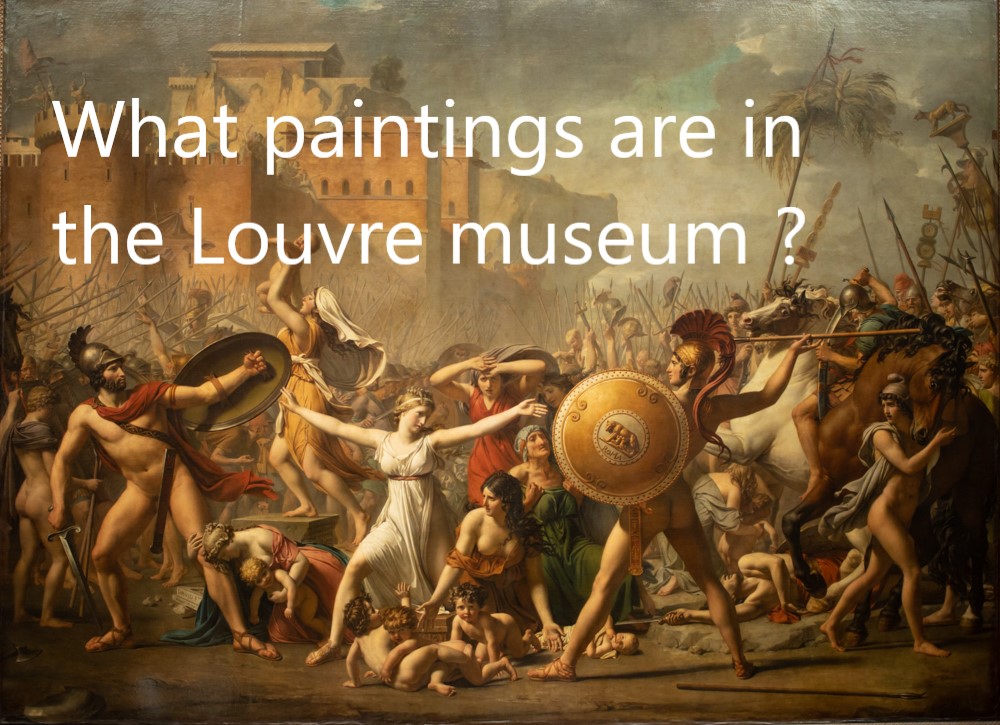
Header photo The Intervention of The Sabine, Louvre Museum, from the city of Paris. Credit photo : Olivier Bergeron
Table of contents
- Mona Lisa – la Joconde
- The Liberty Guiding The People
- The Wedding At Cana
- The raft Of The Medusa
- Saint Stephen preaching in Jerusalem
- Battle of David and Goliath
- Camillus Handing The Schoolmaster of Falerii to his pupils
- Portrait of General Bonaparte
- The Intervention Of The Sabine Women
- Napoleon on the battlefied of Eylau
- Glory Crownings The Art
- The Charging Chasseur
- The virgin and child with six angels
- The Virgin Mary and Infant Jesus
- Going more far
- Reference to Best Museums inParis
- FAQ Best Museums in Paris
Mona Lisa – La Joconde
Certainly the most iconic painting in the Louvres Museum, Mona Lisa was painted in Italy in the period 1503 – 1519. Leonardo Da Vinci took it across the Alps when he was invited by the King of France to reside at the Château du Clos Lucé in Amboise. His enigmatic smile always makes crowds of visitors dream. The painting seems to depict Italian noblewoman Lisa Gherardini, the wife of Francesco del Giocondo.
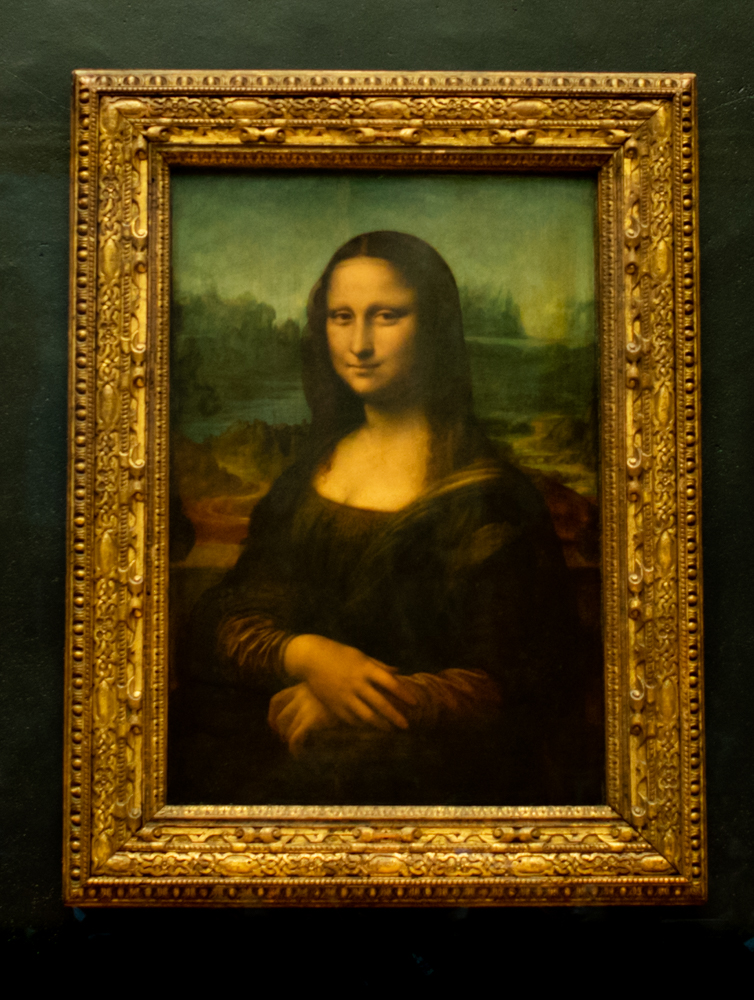
Location : Denon, Room 711
Liberty Guiding the People
Painted in 1830 by Eugène Delacroix, Liberty Leading the People was inspired by the « three glorious revolution », the second French revolution of the 3 days of July 27,28 and 29, 1830.
The painting depicts a scene of a collapsed barricade, crossed by the rioters of the people of Paris who rose up against King Charles X. The Liberty is highlighted by the lighter color of her yellow dress with double belt, in the light.
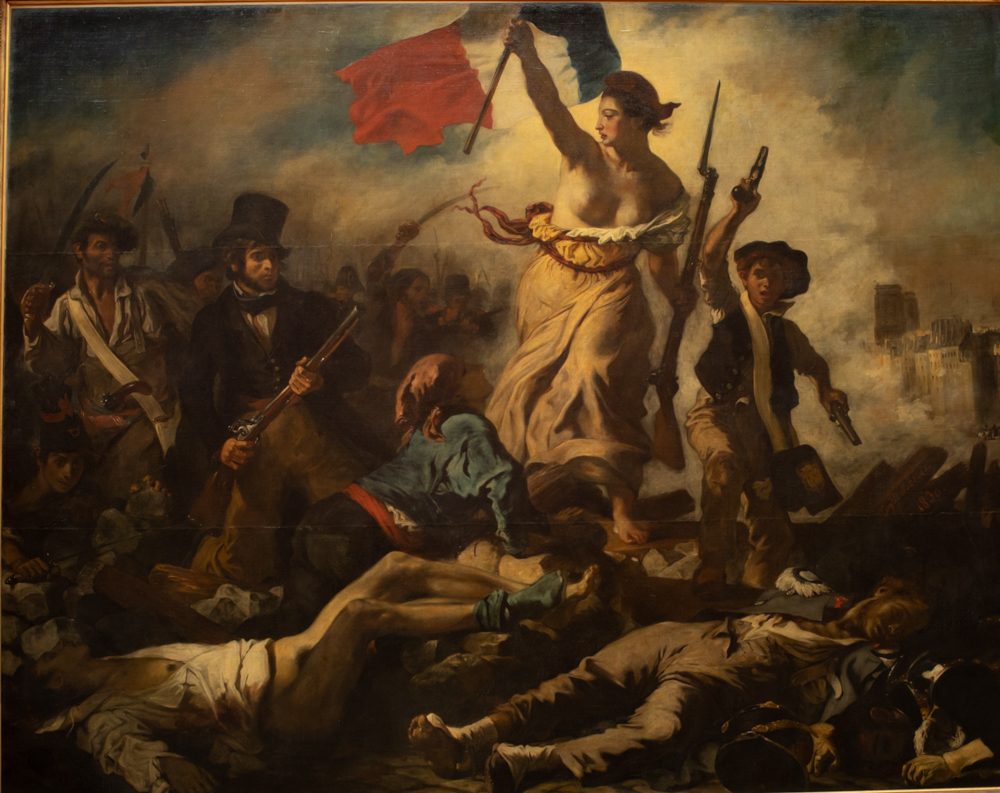
Location : Denon, Room 700
The wedding at Cana
Painted by the Venetian Paolo Caliari, known as Veronese, in 1563, for the refectory of the Benedictines of San Giorgio Maggiore in Venice.
the Marriage of Cana refers to an episode in the life of Jesus Christ during which he was invited to a wedding meal in Cana. The wine runs out during the banquet and Jesus asks to fill the jars with water.
The liquid is poured into the glasses, the guests taste, the water is transformed into wine!!!.
The painting features 132 life-size characters, some of whose portraits represent contemporaries of the work. The newlyweds gave up their place of honor to Jesus and his mother Mary in the center of the table. Although located in the Galilee, the architecture and the clothes are very Venetian.
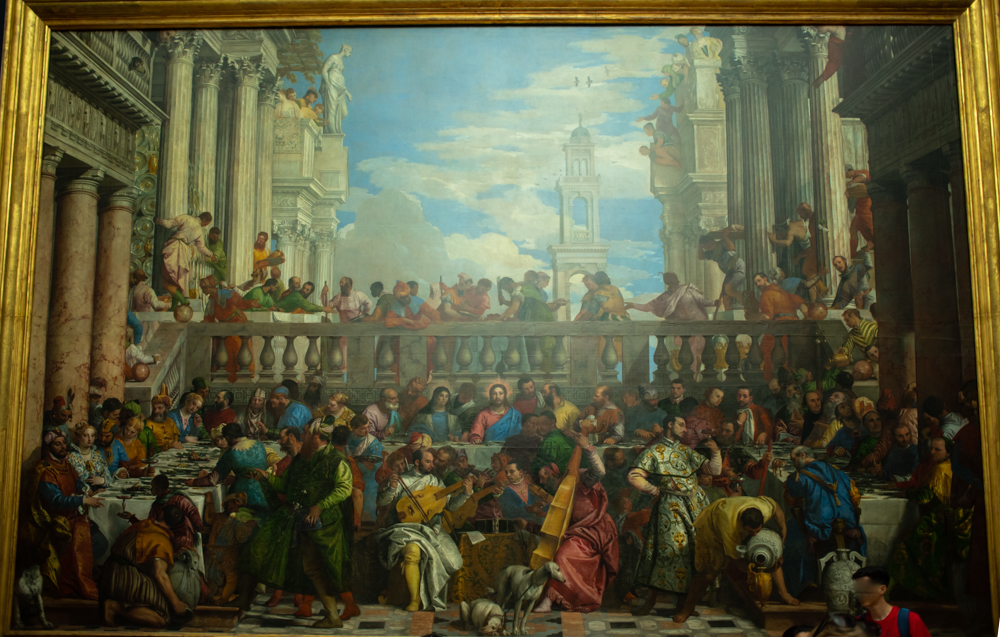
Location : Denon, Room 711
The Raft Of Medusa
Made between 1818 and 1819 by the French painter Théodore Géricault, the Raft of Medusa is inspired by a dramatic real event. Indeed, the frigate Méduse was shipwrecked in 1816 off the coast of Mauritania, causing the death of 160 people, 147 of whom were abandoned on a makeshift raft.
The raft drifted for 13 days and would have given rise to acts of cannibalism.
The work features strong contrasts between light and dark with heavy use of dark pigments. For the ocean, Géricault used a very dark green.
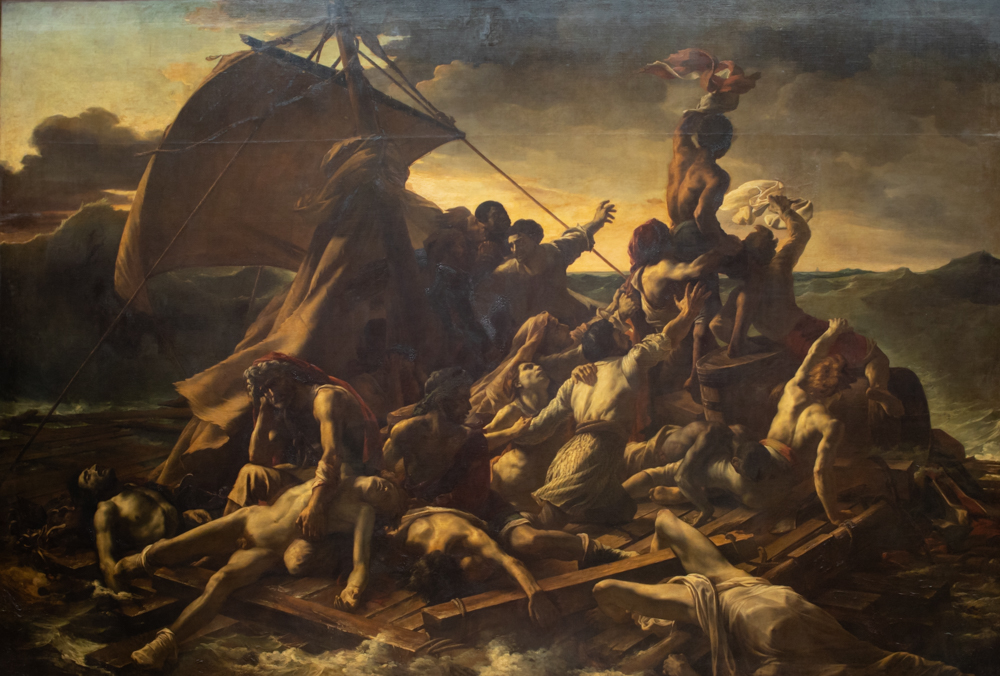
Location : Sully, Room 950
Saint Stephen preaching in Jerusalem
Painted in the first quarter of the 16th century (1500-1525) by Carpaccio, Vittore, this work is part of a series of five paintings illustrating episodes from the life of Saint Stephen, executed between 1511 and 1520 to decorate the Scuola di Santo Stefano of Venice the Sala dell’Albergo, located on the first floor of this building. The saint, who will be stoned, is shown here preaching on the base of a destroyed column – possibly a symbol of the ruin of the ancient world. Saint Stephenpreaches to the inhabitants of Jerusalem on the esplanade of the temple (the current esplanade of the mosques). We can see in the background on the left the Temple built by Solomon. He insisted on the variegation of the crowd, where we recognize Greeks (in black hats on the left), Ottomans (in turbans), Europeans (bare-headed ).
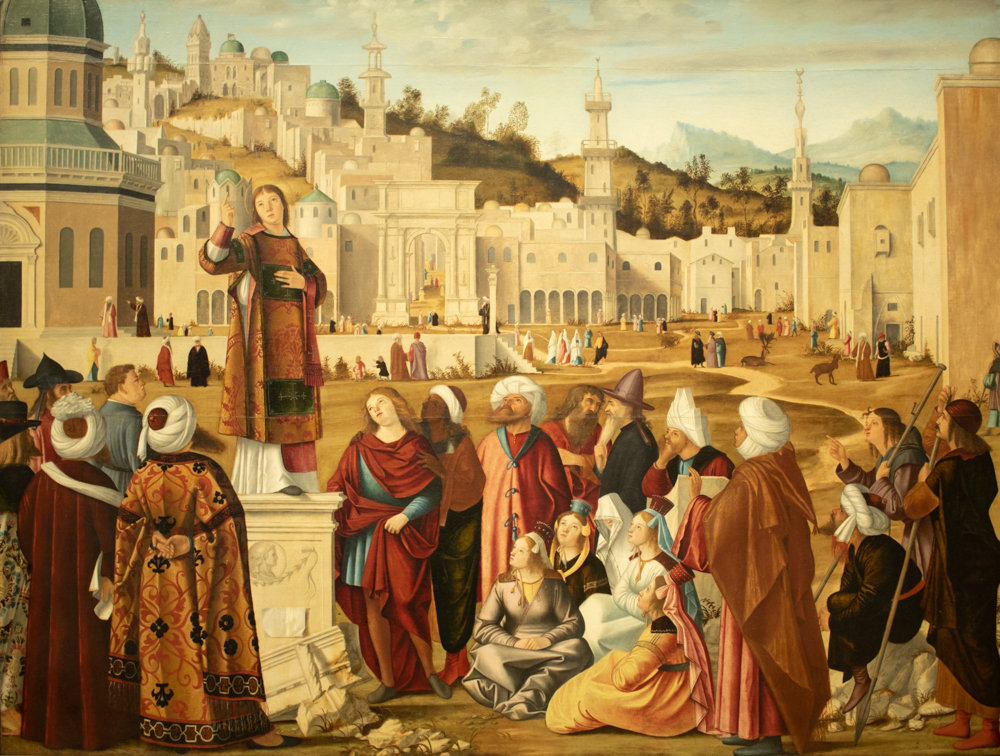
Location : Denon, Room 710 – Grande Galerie / Large Gallery
Battle of David and Goliath
This work is a double-sided painting, made not on a canvas but on a stone, slate, by Daniele Da Volterra, known as Daniele Ricciarelli, in the years 1550-1555.
The work represents a very famous scene: David has just touched Goliath in the forehead, with a stone thrown from his sling. While the giant is on the ground, David grabs his sword (a scimitar) to finish him off.
The painting is exceptional, as there is no other example, both of a painting on such a large slate, and of a painting depicting the same scene seen from the back and from the front. It is both a sculpture and a painting: by the support, but also by the treatment: the volumes are treated with warm tones, the contrast with the dark background makes them stand out even more strongly.
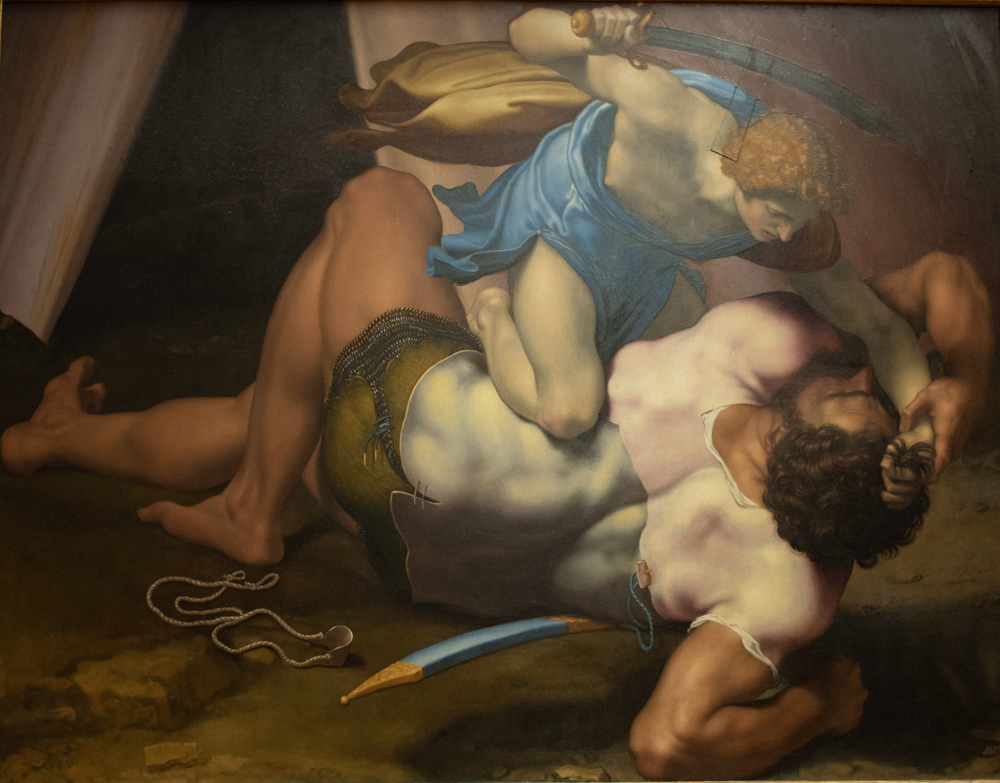
Location : Denon, Room 712 – Large Gallery / Grande Galerie
Camillus Handing The Schoolmaster of Falerii to his pupils
Painted by Nicolas Poussin in 1637, the work depicts a scene from the Roman history of Titus Livius.
The subject illustrates the greatness of soul of Camille, one of the models of virtue (exempla virtutis) of Antiquity. Poussin represented him on the left, dressed in a red drapery, giving the order to have the master escorted back to the city under the boos of his students. The composition unfolds in a frieze, from left to right, like an ancient bas-relief. The artist demonstrates his mastery of “costume” by representing with archaeologist precision the ensigns of the Roman army and the headquarters of the general.
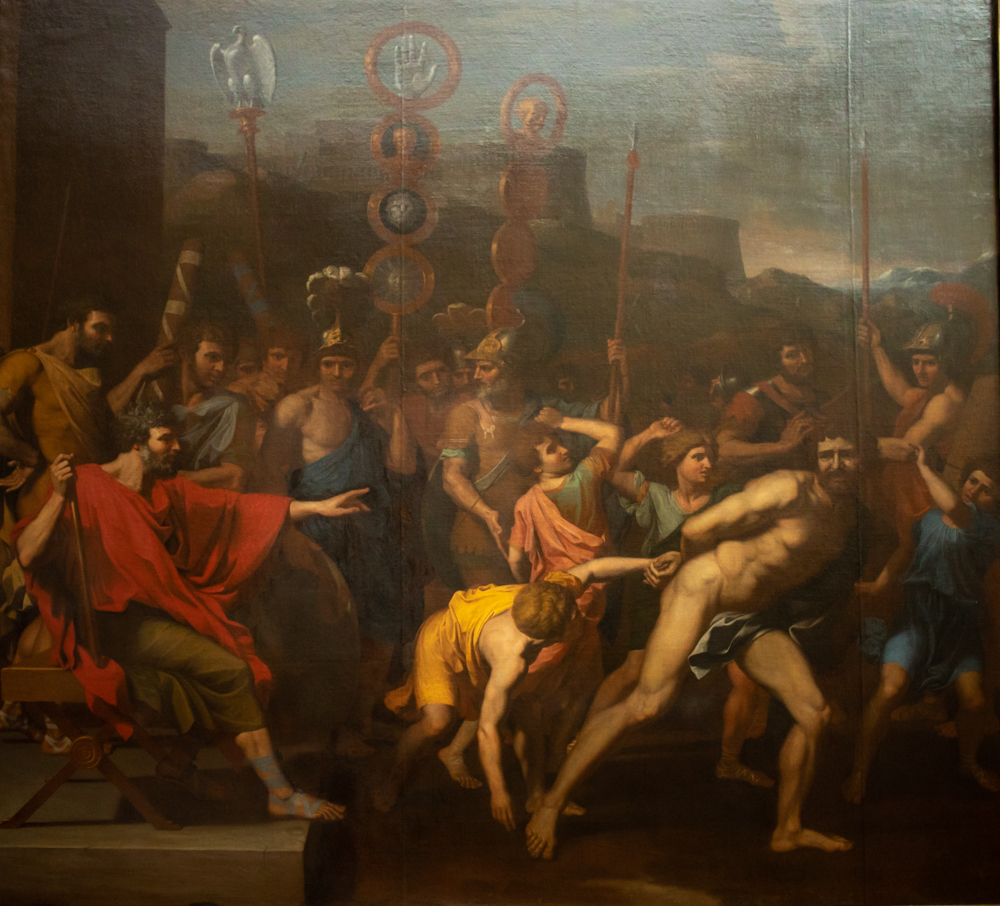
It was the custom of the Faliscans to entrust the same master with the instruction and custody of their sons; several children at the same time, a custom that still exists in Greece today, were entrusted to the care of a single man. The sons of the leading citizens, as almost everywhere, followed the lessons of the most learned and renowned. This man, during the peace, used to drive the children out of town for their games and exercises. As the war had not made him give up this habit, he took them to distances more or less close to the gates of the city, varying their games and his conversations; and one day, when he had advanced further than usual, finding the opportunity propitious, he pushed on to the posts and camp of the Romans, and conducted them straight to Camilla’s tent. There, adding to his infamous action an even more infamous language, he says “That he returned Falerii to the power of the Romans, by delivering to them the sons of the first personages of the city”. Hardly had Camille heard these words: “You will not find here,” he said, “neither a people nor a general who resembles you, an infamous one who comes with an infamous present. We are not attached to the Faliscans by any of those bonds established by the conventions of men; but those imposed by nature are and always will be between them and us. War like peace has its laws, and we have learned to uphold them with fairness as well as valour. We have arms, but it is not against this age that one spares even in the cities taken by storm; it is against armed men like us, and who, without being insulted or provoked by us, attacked the Roman camp at Veii. These, you, as far as it was in your power, you conquered by a crime hitherto unknown; and I will conquer them as I conquered Veii, by courage, labor and arms, as befits a Roman.” Having said this, he strips him, ties his hands behind his back, and has his pupils take him back to Falerii: he had given them rods to strike the traitor with, chasing him before them into the city. At this spectacle, the people having rushed, and then the senate having been invited by the magistrates to deliberate on this strange affair, there took place such a change in the minds, that this city, which formerly carried away by hatred and rage, would almost have preferred the ruin of Veii to the peace of Capenes, called for peace in a unanimous voice. In the forum, in the senate, they speak only of the Roman faith, of the general’s equity, and, by common agreement, they send deputies to Camille in his camp, and from there, with the authorization of Camille , in Rome, to offer the surrender of Falerii to the senate” (book 5, chap. 27).
Location : Denon, Room 716 – Large Gallery / Grande Galerie
Portrait of General Bonaparte
Painted by Jacques-Louis David in 1797/1798, the unfinished work depicts Napoleon Bonaparte, looking at the Alps, on the Rivoli plateau in northern Italy when he was a general.
Shortly after signing the Treaty of Campo-Formio, Bonaparte returned to France where he was welcomed as a hero. During this arrival, David sees the general for the first time, and makes a first sketch of his profile. He meets him at a reception organized by the secretary of the Management Board, Lagarde. Bonaparte having accepted the invitation on the condition that the painter also be invited. During a meeting between the two men during this reception, the idea of the portrait was born. David offers the general to come to the Louvre in his studio to pose, but it will take several reminders from the painter to convince Bonaparte to go there. The session lasts three hours and is not repeated. David abandons the painting to get back to work on Les Sabines. It is also to continue this work that he will decline Bonaparte’s offer to come with him to Egypt, Vivant Denon replacing him.
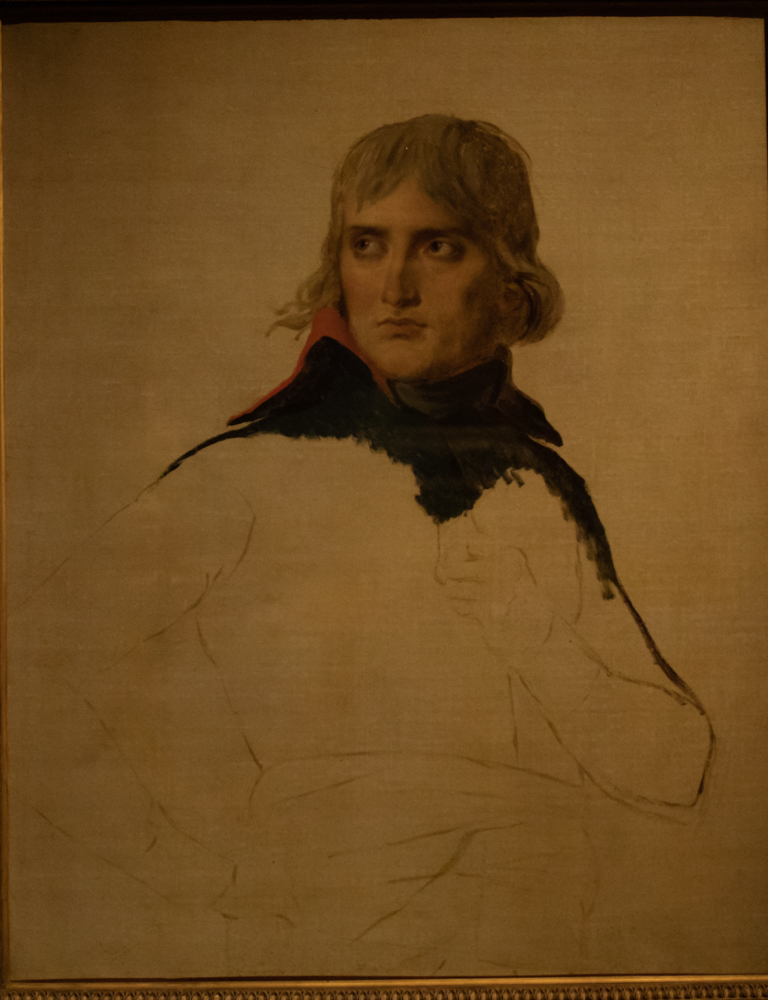
Location : Denon, Room 714 – Collection Beistegui
The Intervention Of The Sabine Women
Inspired by Titus Livius and Plutarch, this work was painted betwwen 1796 and 1799 by Jacques-Louis DAVID.
The scene represents the Sabines who stop a fight between the Romans and the Sabines and more particularly between the Sabine Tatius and the Roman Romulus, his shield representing the Roman wolf and preparing to throw her javelin against Tatius. Hersilia, daughter of Tatius and wife of Romulus, stands in the middle of the stage with her arms raised.
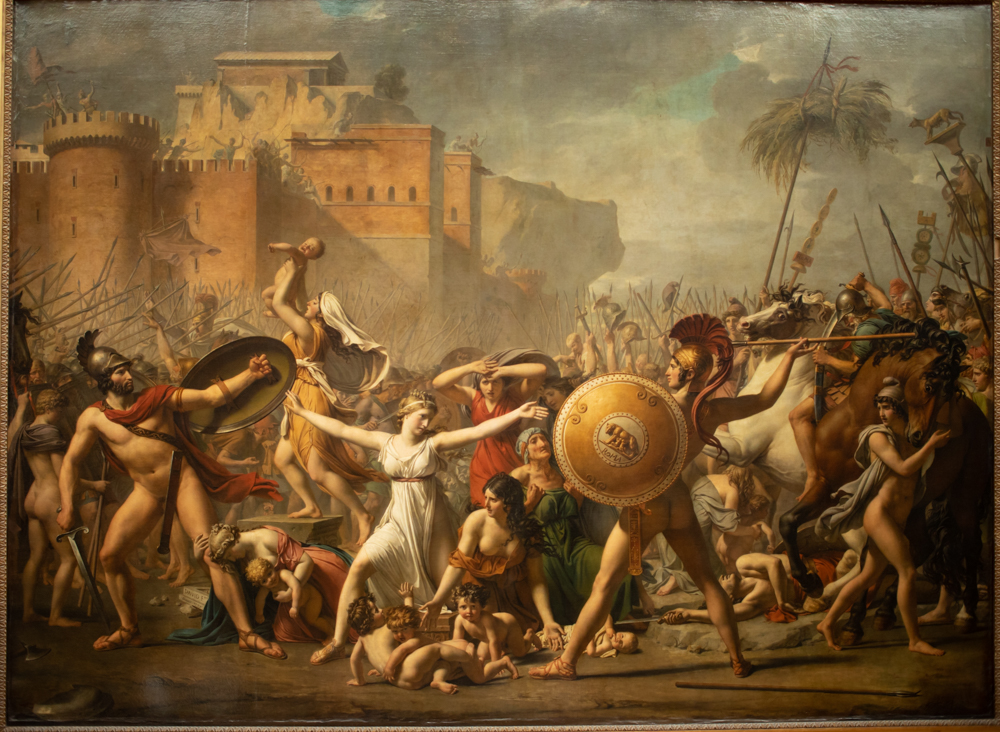
Facing the lances of the Sabines a woman raises her child, another clings to the leg (in antiquity, to touch someone’s knee meant to beg him) of Tatius, a third presents her offspring at the feet of Romulus. On the far right, a horseman puts his saber back in its scabbard.
Location : Denon, Room 702 – Room Daru, néoclassicism
Napoleon on the battlefied of Eylau
Painted by Antoine-Jean GROS during the winter of 1807 – 1808, following an order, the work represents the visit of Emperor Napoleon 1st to the battlefield of Eylau in East Prussia, on February 9, 1807, the next day. of a bloody victory against the Russians and the Prussians.
The emperor is perched on a light horse, his gaze full of compassion. He stretches out his arm as if to bless the wounded. A Lithuanian soldier, supported by the surgeon Percy, talks to him. Another wounded soldier kisses his leg. On the right, Marshal Murat, on a prancing black horse. In the foreground, the bodies of soldiers piled up under the snow, one of which is struggling.
The dramatic atmosphere is reinforced by the snowy landscape and the pale color of the sky
The marshals on horseback escorting Napoleon are:
Berthier, Bessières, Caulaincourt on the left.
Soult, Davout, Murat on the right.
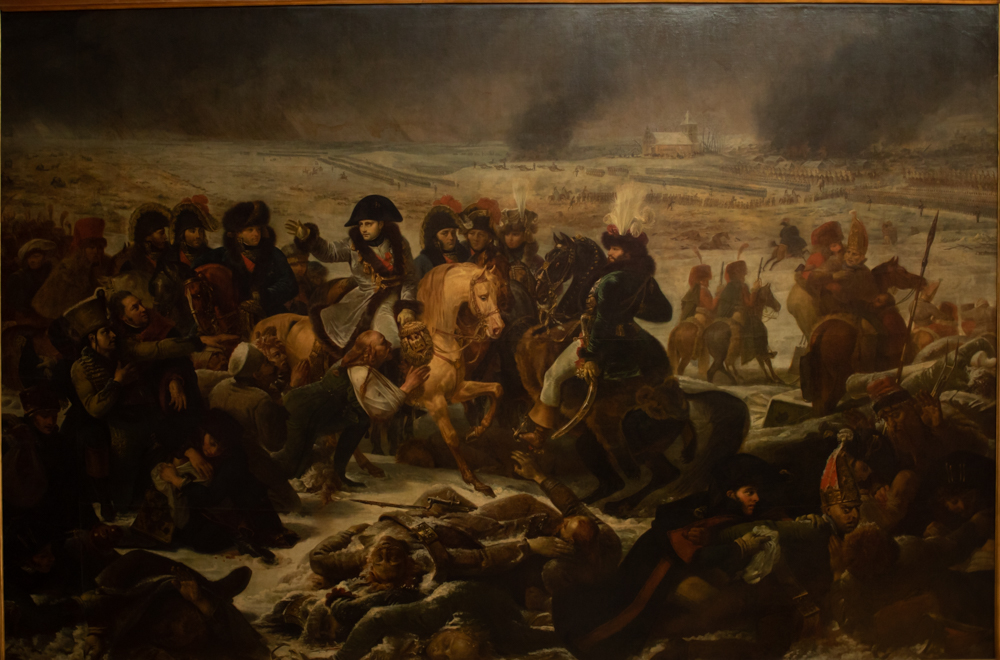
Location : Denon, Room 700 – Room Mollien, romantism
Glory Crownings The Art
Painted by Charles-Louis MULLER between 1850 and 1875, the painting on canvas under a dome represents the allegory of La Gloire distributing palms and crowns.
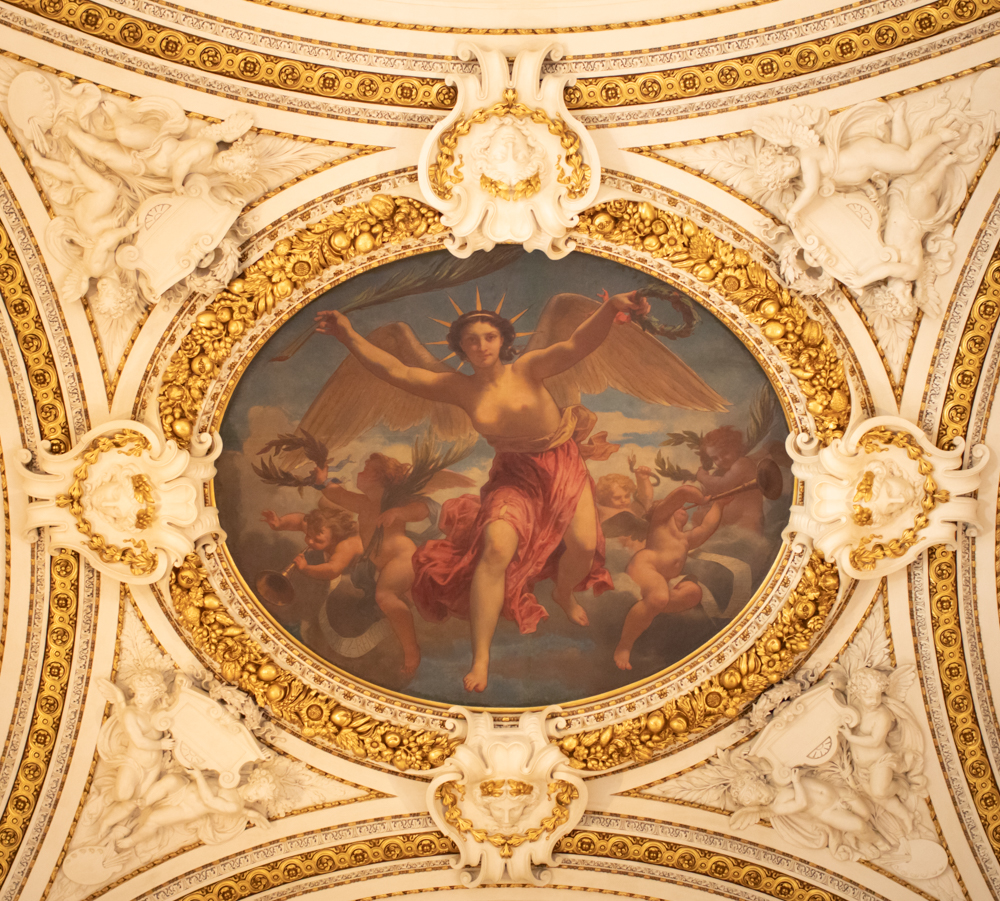
Location : Denon, Italian Sculptures from the Royal Collections – Escalier Mollien
The Charging Chasseur
Painted in 1812 by Théodore Géricault,
The painting depicts an officer of the Imperial Guard mounted chasseurs regiment on a prancing horse. The painting was done in five weeks.
The painting depicts an officer of the Imperial Guard mounted chasseurs regiment on a prancing horse. The painting was done in five weeks
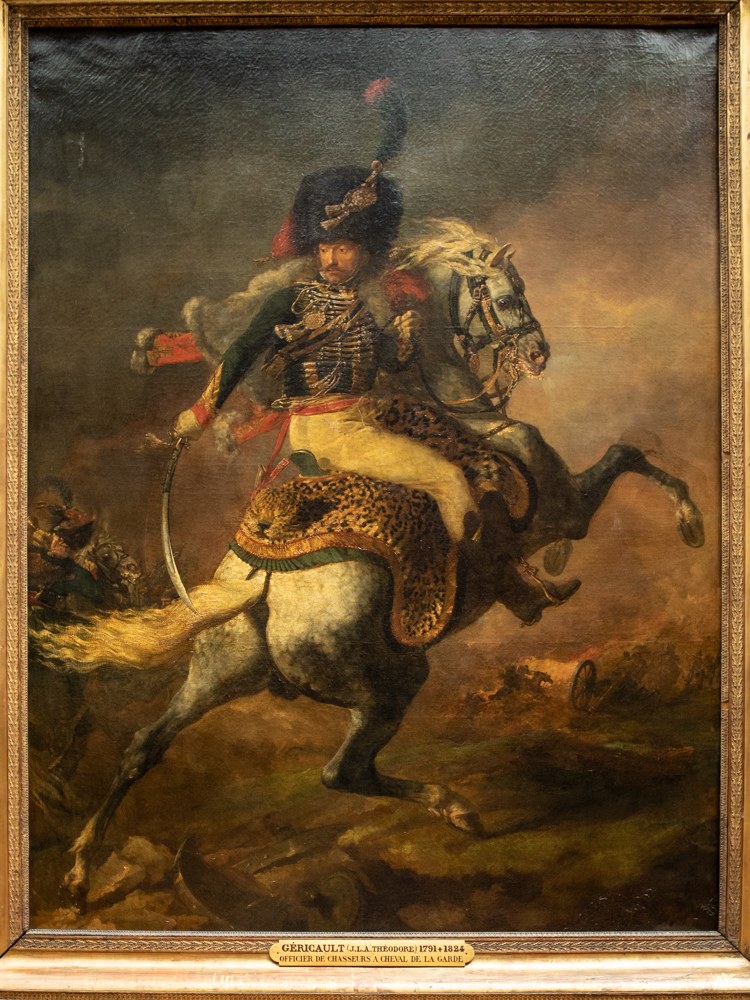
The horse is represented in large size on an oblique and biased line, in perspective. The twists of the rider and the horse give a movement effect to the painting.
Location : Denon, Room 700 – Room Mollien, romantism
The virgin and child with six angels
Painted by Stefano Di Giovanni, known as Sassetta during the period 1437 – 1444 in Siena, The virgin and child with six angels, is an altarpiece commissioned from Sassetta by the friars of the convent of San Francesco de Borgo Sansepolcro for the high altar of their church . The virgin, carrying Jesus, is surrounded by 6 angels and by Saint Anthony of Padua and Saint John The Evangelist.
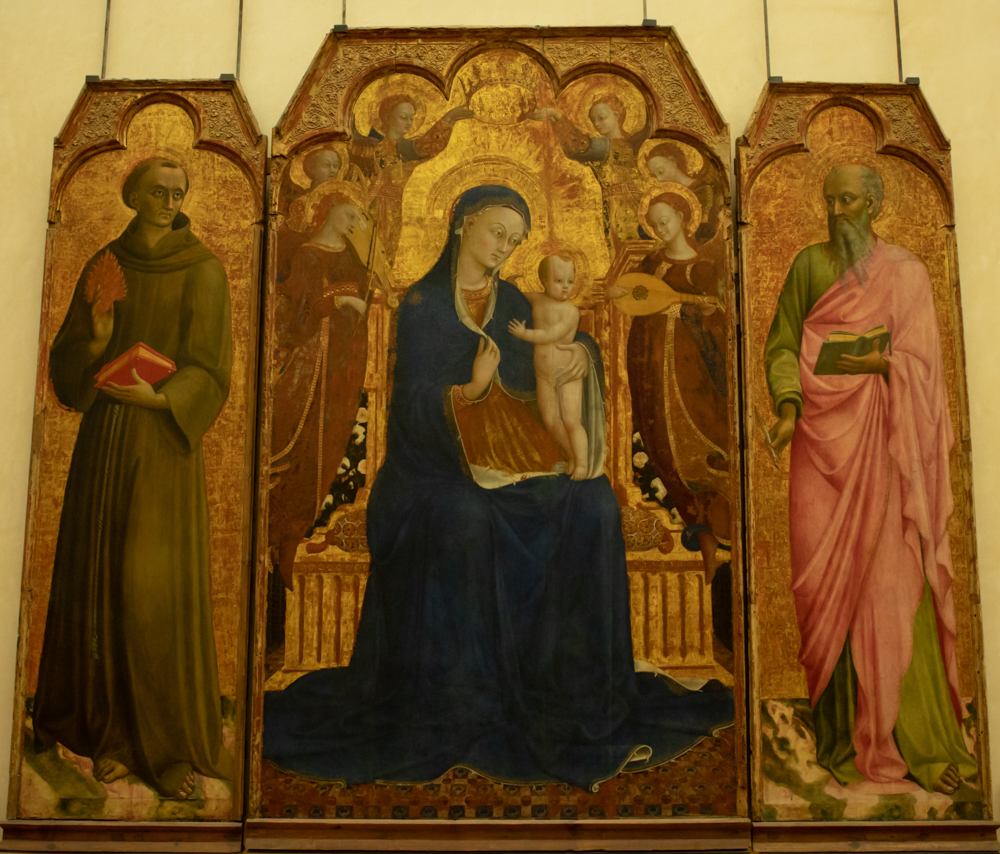
Location : Denon, Room 709 – Room of the 7 Meters / Salle des Sept Mètres
The Virgin Mary and Infant Jesus
Painted in Siena by Ambrogio LORENZETTI during the period 1330 – 1335, it is the central panel of a polyptych representing the Virgin and the child Jesus, haloed in gold, framing a fig.
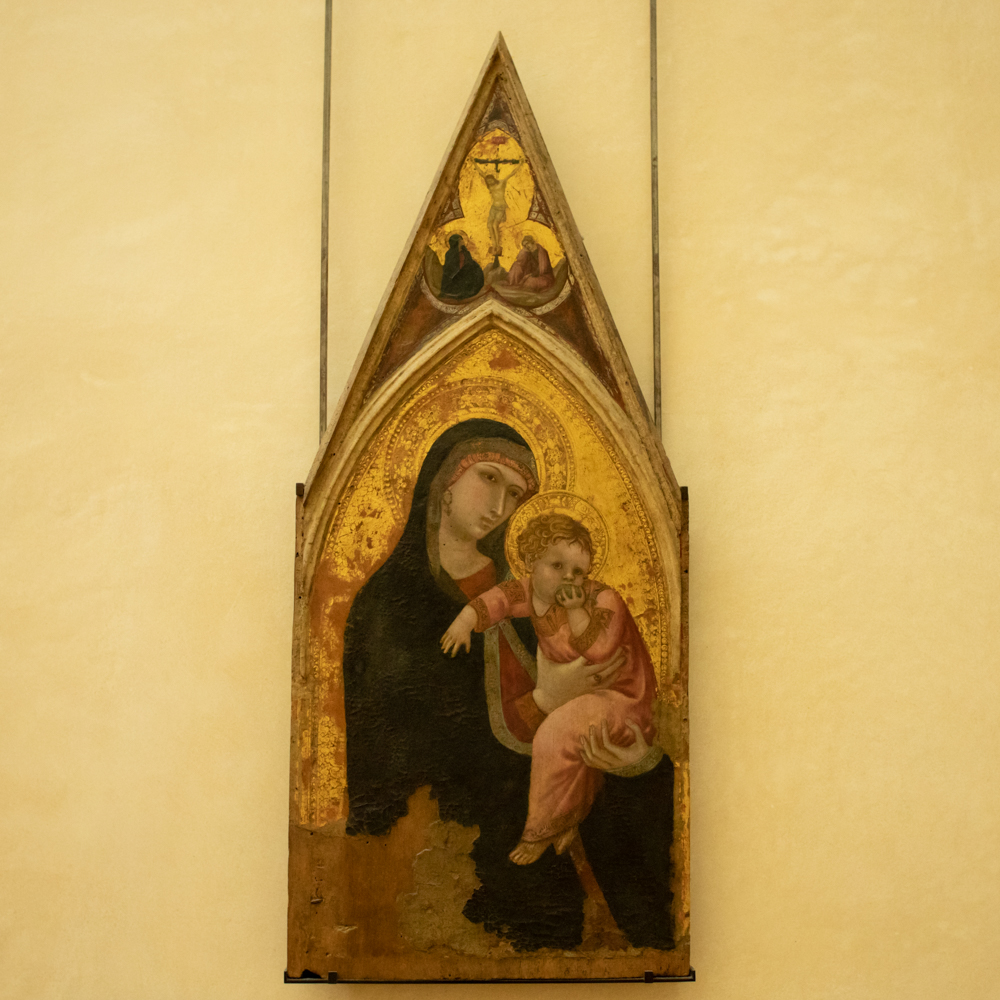
Location : Denon, Room 709 – Room of the 7 Meters / Salle des Sept Mètres
Going more far
La peinture au musée du Louvre, Jean Guiffrey.
Reference what paintings are in the Louvre
Louvre Museum official Website
Saint Etienne prêchant à Jérusalem
FAQ what paintings are in the Louvre
Complements to what paintings are in the Louvre
You may be interested in :